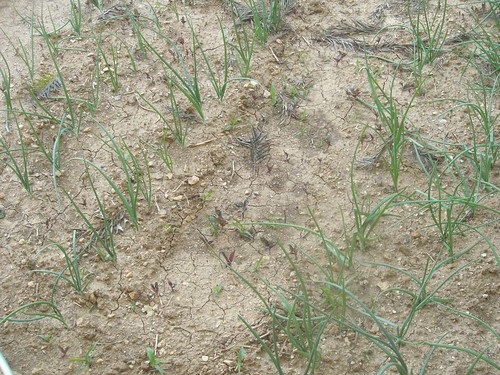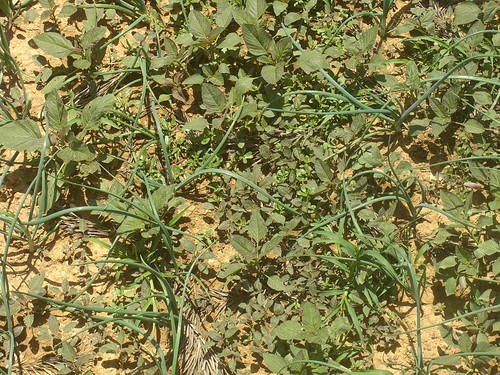In the same patch of soil where we had planted broad beans, my husband planted some onions. The spring rains helped them to sprout more quickly. Along with the thriving onions, little green leaves tinged with purple began to appear. The amaranth plant (what Greeks call 'vlita') is a perennial in the Mediterranean; it re-grows each year without any help (just like artichokes) once it has been planted and allowed to seed completely in the previous year.
As the amaranth plants grew, they lost their purple tinge. Only the new leaves came out purple. They reminded me of a poinsettia plant.
The vlita are added to boiling water. The purple leaves cause the water to turn purple. At their prime (in the spring, when they are perfectly tender and full of moisture), they need about 15 minutes cooking time. This kind of horta is never eaten raw.
The first plate of vlita (customarily eaten with boiled potatoes and zucchini, and dressed in olive oil and lemon juice) for the year is a sure sign of summer in Greece. It's amazing what you can get for free if you have a garden (while other people were paying 1.84 euro a kilo today for the same stuff at the supermarket, which includes the heavy stalks, thereby adding weight to your purchase).
©All Rights Reserved/Organically cooked. No part of this blog may be reproduced and/or copied by any means without prior consent from Maria Verivaki



Yum, just had some horta the other day. The vlita I find here in the markets had that purple tinge...seems to go away upon boiling.
ReplyDeleteEnjoy the weekend!
I will have to check out some Vlita some day. It sounds like my kind of garden plant. Does it taste like spinach?
ReplyDeleteGo Vlita!!!
ReplyDelete(Although i prefer them next to a nice portion of fried gavros (what's the English for γάβρος; I wonder) :-D
(€1.84 for a kg of Vlita??? :-O )
"Gavros" is anchovy!
ReplyDeleteI've never had vlita and to be honest, I've only heard of amaranth as a grain! It's amazing what grows in your garden (or just around you) - it makes me wonder if there's something edible in our yard that we overlook!
ReplyDeleteIn Greece is the only place I have ever tried vlita. My friends had it at every meal:D
ReplyDeleteLovely color! I prefere the version with the boiled potatoes and zucchini but without lemon juice...just plain olive oil!
ReplyDeleteI've never had this, but I know the joys of having a garden! So far,mine is growing well, but the rabbits have found my green beans!
ReplyDeleteThank you, thank you Maria. I now know the name of this weed that I grew up eating. I never knew the name in English or Turkish. In fact, last summer when I came from home, my aunt gave me some already boiled amaranth and I made borek with it. However, I couldn’t post it because I had no idea what it’s called. This is so helpful.
ReplyDeletegreat post Maria. I was wondering if you do "feed" your garden plants with fertilizers and if you do what they are? I do not know what to think of those blueish powders on the store shelves. I guess they are not pesticides but I am not sure they are too good for us either. thanks!
ReplyDeletethis part of the garden isnt fed anything - it grows pretty much unattended. we do feed the summer plants with the basic NPK mixture, and the bluish powder, which is actually some kind of sulphur powder whick keeps away mites, but doesnt harm you. you cant eat anything dusted with the powder for the next 20 days, but it washes off - it doesn't sink into the 'blood' supply of the plant
ReplyDeletegood point you raise about fertilising plants - unfortunately, if you dont fertilise, you wont eat much, but if you are the one adding the fertiliser, you can control what goes into it